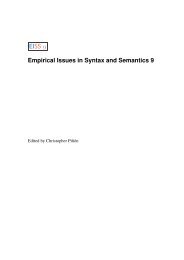Polysemy and Pancakes - CSSP
Polysemy and Pancakes - CSSP
Polysemy and Pancakes - CSSP
Create successful ePaper yourself
Turn your PDF publications into a flip-book with our unique Google optimized e-Paper software.
. Det är gott {[att äta pannkakor]/ *pannkakor}<br />
it is good to eat pancakes pancakes<br />
‘It is good to eat pancakes.’<br />
(4) a. Jag fortsatt {[(att) äta pannkakor] / *[pannkakor]}.<br />
I continued (to) eat pancakes pancakes<br />
‘I continued to eat pancakes.’ / ‘*I continued pancakes.’<br />
b. Jag är villig {[att äta pannkakor]/ *[pannkakor]}.<br />
I am willing to eat pancakes pancakes<br />
‘I am willing to eat pancakes.’ / ‘*I am willing pancakes.’<br />
c. Jag har lust {[att äta pannkakor]/ *[pannkakor]}.<br />
I have desire to eat pancakes pancakes<br />
‘I want to eat pancakes.’<br />
(lit. I have desire to eat pancakes./ *I have desire pancakes.)<br />
(5) Det är gott med {*[att äta pannkakor]/ [pannkakor]}.<br />
it is good with to eat pancakes / pancakes<br />
roughly, ‘Eating pancakes is nice.’<br />
The contrasts in 3-5 are unexpected if pannkakor can be a covert infinitive. Hellan<br />
(1986:96) notes another problem for SHH: the putative source 6b is infelicitous:<br />
(6) a. Vodka er sunt å drikke. (Norwegian)<br />
vodka[MASC] is healthy.NT.SG to drink<br />
‘Vodka is healthy to drink.’<br />
b. *Å drikke vodka er sunt å drikke.<br />
(‘To drink vodka is healthy to drink.’)<br />
Josefsson (2009, 43), arguing for SHH, notes that pancake-NPs can contain reflexive<br />
pronouns which, she suggests, are bound by the PRO subject of a silent ‘light verb’:<br />
[hemfärd till USA utan sin dotter] ‘hometravel to USA without self’s daughter’. But<br />
such reflexives can also be bound within NPs in Swedish, by genitives or by implicit<br />
agents, so these data do not favor either hypothesis.<br />
Either hypothesis allows us to preserve 1a. Alternatively, 1a may be replaced by<br />
a Bayesian version in which the syntactic <strong>and</strong> semantic features are allowed to compete<br />
probabilistically (Pearl 1988, 49ff; Kjaerulff <strong>and</strong> Madsen 2007, 25ff).<br />
Selected References: Copestake, A., <strong>and</strong> T. Briscoe. 1995. Semi-productive <strong>Polysemy</strong> <strong>and</strong> Sense<br />
Extension. J of Sem 12, no. 1: 15. • Enger, H-O. 2004. Sc<strong>and</strong>inavian pancake sentences as<br />
semantic agreement. Nordic J of Ling 27, no. 01: 5-34. • Faarlund, J.T. 1977. Embedded clause<br />
reduction <strong>and</strong> Sc<strong>and</strong>inavian gender agreement. J of L: 239-257. • Josefsson, G. 2009. Peas <strong>and</strong><br />
<strong>Pancakes</strong>: On apparent disagreement <strong>and</strong> (null) light verbs in Swedish. Nordic J of Ling 32, no.<br />
01: 35-72. • Wechsler, S. (in press). ‘Mixed Agreement, the Person Feature, <strong>and</strong> the<br />
Index/Concord Distinction.’ NLLT. • Wechsler, S. <strong>and</strong> H.-J. Hahm 2011. ‘Number Markedness<br />
<strong>and</strong> Polite Plurals’. Morphology 21:247–281.<br />
2











